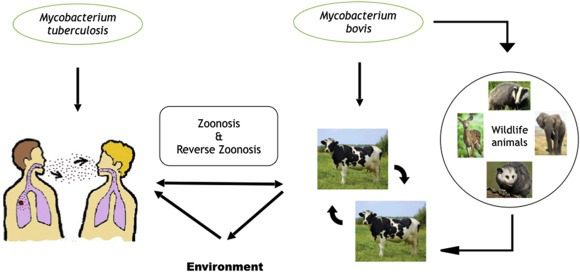TB

Bovine Tuberculosis (TB) is an infectious disease of cattle. It is caused by the bacterium Mycobacterium bovis (M. bovis
Bovine TB is caused by a bacterium called Mycobacterium bovis, (M. bovis) which is closely related to the bacterium that causes human and avian tuberculosis.
All mammalian species, including humans, are susceptible to bovine TB.
It is mainly a respiratory disease. Transmission can occur through nose to nose contact and also through contact with saliva, urine, faeces and milk.
Cattle can become infected when directly exposed to infectious cattle (or other infectious animals) and their excretions. The movement of cattle with undetected infection is the most likely way that disease spreads to new areas.
How to spot bovine TB
It is hard to spot bovine TB as the signs are similar to other diseases and normally only develop in advanced stages of infection.
The disease is normally picked up in the compulsory cattle testing programme before clinical signs develop. Occasionally it is also detected during inspections of slaughtered cattle.
But you should look out for cattle that:
- keep getting thinner
- have a light fever that keeps coming back
- are weak and have a reduced appetite
Some infected cattle will also have:
- swollen lymph nodes, for example in the neck
- a moist cough that gets worse in the morning and during cold weather or exercise
- chronic mastitis (an infection of the udder that is not cured by the conventional antibiotic therapy)
Risk to humans
Humans can catch bovine TB through:
- unpasteurised milk or dairy products from an infected cow, buffalo, goat or sheep
- inhaling bacteria breathed out by infected animals
- inhaling bacteria released from the carcasses of infected animals or from their excretions (such as faeces)
Infection is more likely if an unprotected wound is exposed to bacteria from an infected animal.
But the risk of infection is very low for the vast majority of the population.
Symptoms are similar to human TB, including weight loss, fever, night sweats and a persistent cough. If you develop these symptoms consult a doctor. The disease can be treated by a complex combination of drugs over a long period.
How to reduce the risk of infection
To avoid infection:
- isolate suspect animals and their carcasses
- do not get too close to the heads of infected animals or hold them
- avoid unpasteurised milk from suspect animals
- wash your hands regularly, especially before eating and smoking
- don’t eat, drink or smoke in animal areas
How bovine TB is spread
Bovine TB is mainly spread into new herds through the movement of infected cattle that have not been detected.
In parts of the country this disease is also spread from infected badgers to other animals, including cattle, and vice versa.
Infected animals spread the disease mainly through coughing and sneezing. Bacteria are released into the air and inhaled by other animals in close contact.
The disease can also be spread:
- from infected cows to their offspring during suckling and, much more rarely, in the womb
- through contaminated equipment, animal waste, feed and pasture
